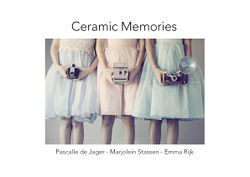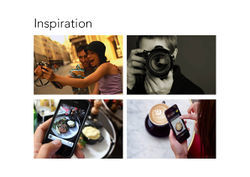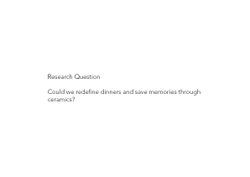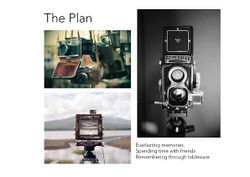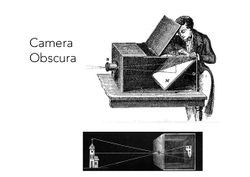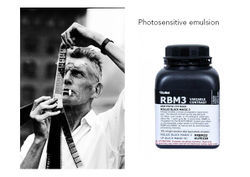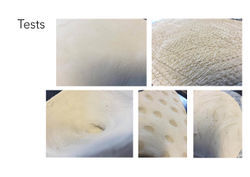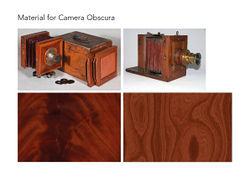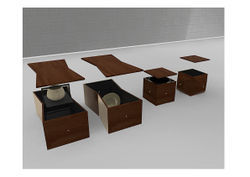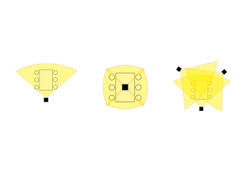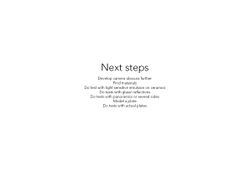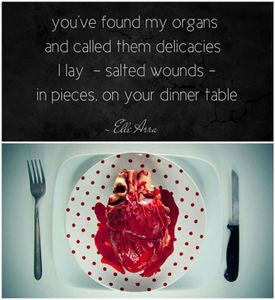Difference between revisions of "User:Emma Rijk/UTC"
(Created page with "=Introduction= Ceramic Memory contains three group members: Marjolein Stassen, Pascalle de Jager and Emma Rijk. In the previous quarter Marjolein Stassen and Emma Rijk have b...") |
|||
| Line 1: | Line 1: | ||
| − | =Introduction= | + | ==Introduction== |
Ceramic Memory contains three group members: Marjolein Stassen, Pascalle de Jager and Emma Rijk. | Ceramic Memory contains three group members: Marjolein Stassen, Pascalle de Jager and Emma Rijk. | ||
| Line 14: | Line 14: | ||
visual on the object placed in the box, making the memory last forever without sacrificing precious time. | visual on the object placed in the box, making the memory last forever without sacrificing precious time. | ||
| − | <gallery mode="nolines" widths=" | + | <gallery mode="nolines" widths="250px" heights="250px"> |
presentatie_ceramic_memory.jpg| | presentatie_ceramic_memory.jpg| | ||
presentatie_ceramic_memory2.jpg| | presentatie_ceramic_memory2.jpg| | ||
| Line 27: | Line 27: | ||
presentatie_ceramic_memory11.jpg| | presentatie_ceramic_memory11.jpg| | ||
</gallery> | </gallery> | ||
| + | |||
| + | == Progress 04-10 Future Food == | ||
| + | |||
| + | What happens when people eat and everything except for the food is registered? | ||
| + | Wich things make our sitting together and having food an exceptional experience? | ||
| + | |||
| + | In this week we decided to take a more poetic approach to the future food concept. | ||
| + | We mainly want to focus on the stories told while eating. | ||
| + | |||
| + | <gallery mode="nolines" widths="300px" heights="300px"> | ||
| + | |||
| + | Eat8.jpg|Poetry and food combined | ||
| + | |||
| + | </gallery> | ||
| + | |||
| + | During our conversations we decided to focus on the stories being told while having dinner together. | ||
| + | Just like the program 'Man Bijt Hond' we will go to people and join them while having food together. | ||
| + | The stories that are being told while function as a tool to create our memory machine. | ||
| + | |||
| + | We also found inspiration in the hitsong of Adele; Turning tables | ||
| + | [https://www.youtube.com/watch?v=dx7sLNyIeQk] | ||
| + | |||
| + | Adele found her inspiration for this song while having dinner with her friends in a restaurant that has turning tables. | ||
| + | |||
| + | Research about sound pitches: [http://scienceprojectideasforkids.com/2010/sound-pitch-loudness/] | ||
| + | [http://www.slideshare.net/krunalThanki/acoustics-and-sound-insulations-by-k-r-thanki] | ||
| + | |||
| + | == FUTURE FOOD == | ||
| + | Insects, fake meat, seaweed and 3D-printed food all have the potential to address malnutrition. | ||
| + | |||
| + | * No cutlery needed, only powers and drinks. | ||
| + | * Mini-livestock (Insects) | ||
| + | * Lab-grown Meat | ||
| + | * Algae | ||
| + | * Seaweed | ||
| + | |||
| + | Earlier this year, Dutch scientists successfully produced in-vitro meat, also known as cultured meat. They grew strips of muscle tissue using stem cells taken from cows, which were said to resemble calamari in appearance. They hope to create the world's first "test-tube burger" by the end of the year. | ||
| + | |||
| + | *http://www.theguardian.com/global-development-professionals-network/2014/aug/12/insects-algae-lab-meat-food | ||
| + | *http://www.bbc.com/news/magazine-18813075 | ||
| + | *https://www.youtube.com/watch?v=lCNSst-_z5c | ||
| + | *https://youtu.be/hZ8an4GHEfo | ||
| + | |||
| + | Underused and Overlooked | ||
| + | |||
| + | About 2,500 plant species have been domesticated for food. But today, almost half our food calories come from just three grains: wheat, maize, and rice. What about the thousands of overlooked plant species—and an untapped diversity of animals? These resources could provide solutions to problems like the need for resilience in our food production systems and the need to meet growing demands without depleting natural resources. Here are a few promising examples: | ||
| + | |||
| + | Algae: Seaweed and other algae, already popular in Japan, are highly nutritious and can be grown in both fresh water and salt water. | ||
| + | Insects: Over 2,000 species of insects are already eaten worldwide, including mopane worms (Gonimbrasia belina) in South Africa. Insects are high in protein and require much less land, water, and food than animals raised for meat | ||
| + | Quinoa: This grain (Chenopodium quinoa) from the Andes contains all the essential amino acids the human body needs for protein and has no gluten. | ||
| + | Emmer wheat: While millions are spent on high-tech hybrids, neglected crops like the grain emmer (Triticum dicoccum), which requires less fertilizer and fewer pesticides than currently used breeds, are already being grown in places like Turkey. | ||
| + | Minor millets: These cereals have been grown in Asia for 6,500 years. Many farmers in India and Nepal are now switching from growing crops like maize and rice back to traditional varieties bred to grow on local mountainsides. | ||
| + | Peach palm: The peach palm (Bactris gasipaes) grows well in Central and South America and produces a large, nutritious fruit. The tree’s spiny trunk makes the fruit hard to harvest—but breeders are now developing spineless varieties. | ||
| + | Giant swamp taro: The giant swamp taro (Cyrtosperma chamissonis), which grows well in the salty, sandy soil of many Pacific islands, is rich in vitamins and minerals. Yellow varieties are high in beta carotene, which can help prevent blindness. | ||
| + | Sea buckthorn: Sea buckthorn (Hippophae rhamnoides) uses nitrogen from the air as fertilizer, thanks to specialized bacteria in its roots. These dense roots are also used to prevent soil erosion in China. The berries are hard to pick, but new machines should help with the harvest. | ||
| + | Foods of Tomorrow? | ||
| + | |||
| + | Many foods we’ll eat in the future don’t yet exist. Researchers constantly tinker with plant and animal ingredients, | ||
| + | processed foods and even packaging, to improve flavor and nutrition. A few samples are below—but the biggest | ||
| + | changes may come from ideas we cannot yet imagine. | ||
| + | |||
| + | Breathable Chocolate: Want the flavor of real chocolate, without the calories? You can now inhale tiny particles of chocolate, as a mist. | ||
| + | Patch in a Pinch: Some essential nutrients could soon be given to soldiers and astronauts through a patch on the skin, for quick absorption in emergencies. | ||
| + | "Smart Packaging": In the near future, food packaging could monitor foods to detect ripeness or spoiling—or even actively prevent foods from spoiling. | ||
| + | |||
| + | GOING FROM INDUSTRIAL MODEL TO ECOLOGICAL MODEL | ||
| + | |||
| + | == CUTLERY / TABLEWEAR == | ||
| + | |||
| + | '''Cutlery''' refers to any hand implement used in preparing, serving, and especially eating food in the Western world. A "cutler" is a person who makes or sells cutlery. The city of Sheffield in England has been famous for the production of cutlery since the 17th century and a train - the Master Cutler - running from Sheffield to London was named after the industry. | ||
| + | |||
| + | Cutlery is more usually known as silverware or flatware in the United States, where cutlery usually means knives and related cutting instruments. Although the term silverware is used irrespective of the material composition of the utensils, the term tableware has come into use to avoid the implication that they are made of silver. | ||
| + | |||
| + | The major items of cutlery in the Western world are the knife, fork and spoon. In recent times, hybrid versions of cutlery have been made combining the functionality of different eating implements, including the spork (spoon / fork), spife (spoon / knife), and knork (knife / fork) or the sporf which is all three. | ||
| + | |||
| + | *[https://en.wikipedia.org/wiki/Cutlery Cutlery] | ||
| + | *[https://en.wikipedia.org/wiki/List_of_eating_utensils List of Eating Utensils] | ||
| + | |||
| + | '''Tableware''' is the dishes or dishware used for setting a table, serving food and dining. It includes cutlery, glassware, serving dishes and other useful items for practical as well as decorative purposes. The quality, nature, variety and number of objects varies according to culture, religion, number of diners, cuisine and occasion. For example, Middle Eastern, Indian or Polynesian food culture and cuisine sometimes limits tableware to serving dishes, using bread or leaves as individual plates. Special occasions are usually reflected in higher quality tableware. | ||
| + | |||
| + | "Dinnerware" is another term used to refer to tableware and "crockery" refers to ceramic dishes in everyday use as differentiated them from the fine porcelain and bone china produced by makers such as Sèvres in France, Meissen in Germany, Royal Copenhagen in Denmark, Royal Doulton in England, or Belleek Pottery in Ireland.[4] Sets of dishes are referred to as a table service, dinner service or service set. Table settings or place settings are the dishes, cutlery and glassware used for formal and informal dining. In Ireland such items are normally referred to as delph, the word being an English language phonetic spelling of the word delft, the town from which so much delftware came. Silver service or butler service are methods for a butler or waiter to serve a meal. | ||
| + | |||
| + | Setting the table refers to arranging the tableware, including individual place settings for each diner at the table as well as decorating the table itself in a manner suitable for the occasion. Tableware and table decoration is typically more elaborate for special occasions. Unusual dining locations demand tableware be adapted. | ||
| + | |||
| + | https://en.wikipedia.org/wiki/Tableware | ||
| + | |||
| + | == History == | ||
| + | |||
| + | The first documented use of the term "cutler" in Sheffield appeared in a 1297 tax return. A Sheffield knife was listed in the King's possession in the Tower of London fifty years later. Several knives dating from the 14th century are on display at the Cutlers' Hall in Sheffield.[2] | ||
| + | |||
| + | Cutlery has been made in many places. In Britain, the industry became concentrated by the late 16th century in and around Birmingham and Sheffield. However, the Birmingham industry increasingly concentrated on swords, made by "long cutlers", and on other edged tools, whereas the Sheffield industry concentrated on knives. | ||
| + | |||
| + | At Sheffield the trade of cutler became divided, with allied trades such as razormaker, awlbladesmith, shearsmith and forkmaker emerging and becoming distinct trades by the 18th century. | ||
| + | |||
| + | Before the mid 19th century when cheap mild steel became available due to new methods of steelmaking, knives (and other edged tools) were made by welding a strip of steel on to the piece of iron that was to be formed into a knife, or sandwiching a strip of steel between two pieces of iron. This was done because steel was then a much more expensive commodity than iron. Modern blades are sometimes laminated, but for a different reason. Since the hardest steel is brittle, a layer of hard steel may be laid between two layers of a milder, less brittle steel, for a blade that keeps a sharp edge well, and is less likely to break in service. | ||
| + | |||
| + | After fabrication, the knife had to be sharpened, originally on a grindstone, but from the late medieval period in a blade mill or (as they were known in the Sheffield region) a cutlers wheel. | ||
| + | |||
| + | |||
| + | == TABLEWEAR AS MEMORY MAKING TOOLS == | ||
| + | |||
| + | Each thing on the table will record a certain pitch (connected to an emotion). The whole set on the table will record the conversation but to play the memory you will need all the table wear to re-play the conversation. | ||
| + | |||
| + | Under Tableware we see: | ||
| + | * Plate | ||
| + | * Knife | ||
| + | * Fork | ||
| + | * Spoon | ||
| + | * Tablemat | ||
| + | * Drinking Glass / Karaf | ||
| + | * Food Dish | ||
| + | |||
| + | What you need: | ||
| + | * Table | ||
| + | * 4 Chairs | ||
| + | |||
| + | Object Use: | ||
| + | * Plate = Middle | ||
| + | * Knife = High Pitch (sharp) | ||
| + | * Fork = Middle//high | ||
| + | * Spoon = Low/Middle | ||
| + | * Tablemat = Low Pitch (bottom) | ||
| + | * Drinking Glass / Karaf = Ultra High | ||
| + | * Food Dish = background noises. Other. | ||
| + | |||
| + | * Table = Speaker | ||
| + | * 4 Chairs + Complete tableware set = record | ||
| + | |||
| + | == INSTANT MOMENT RECORDER == | ||
| + | As part of a dining experience we will design a cube that is always listening to your conversations. Once something memorable happens you can push over the cube and then it will play the last 15 secs. If you want to save it you can do so with a single tap. | ||
| + | |||
| + | [http://www.thingiverse.com/thing:34286 Link Lasercut] | ||
| + | |||
| + | Possible parts for the recording cube: | ||
| + | * [http://www.miniinthebox.com/nl/opgewaardeerd-2-4ghz-nrf24l01-wireless-transceiver-module-voor-arduino-zwart_p683437.html wireless tranceiver for arduino with 2,4ghz reach] | ||
| + | * [http://www.miniinthebox.com/nl/ds3231-high-precision-real-time-clock-module-blauw-3-3-5-5v_p680551.html DS3231 High Precision Real-Time Clock Module - Blauw (3.3 ~ 5.5V)] | ||
| + | * [http://www.miniinthebox.com/nl/raak-sensor-modules-voor-arduino_p3156971.html touch knop] | ||
| + | * [http://www.miniinthebox.com/nl/automotive-sound-filter-fuse-box-5v-stabilizer_p1211996.html sound filter] | ||
Revision as of 19:03, 17 January 2016
Contents
Introduction
Ceramic Memory contains three group members: Marjolein Stassen, Pascalle de Jager and Emma Rijk. In the previous quarter Marjolein Stassen and Emma Rijk have been looking for ways to remember precious memories. The focus was on memories that are made with several people together while having food. Because the moments we are with friends is to good for being behind a camera or waiting for that 'perfect' moment we were thinking about an automatic memory saver.
In this semester we took our idea to the next level. By creating a new tool to save memories on cutlery, the memory does not only last but also reminds the person daily while eating from their cutlery. The tool we use is an camera obscura, which is a dark space (can be anything) with a hole in the surface to let a little light in. The ceramic object will be placed in the small dark space after a lightsensitive formula treatment. The dark space (box) can be placed on the table while having dinner with friends. If the lighthole is opened during dinner, the picture will develop while having dinner. The picture of everyone having dinner will be visual on the object placed in the box, making the memory last forever without sacrificing precious time.
Progress 04-10 Future Food
What happens when people eat and everything except for the food is registered? Wich things make our sitting together and having food an exceptional experience?
In this week we decided to take a more poetic approach to the future food concept. We mainly want to focus on the stories told while eating.
During our conversations we decided to focus on the stories being told while having dinner together. Just like the program 'Man Bijt Hond' we will go to people and join them while having food together. The stories that are being told while function as a tool to create our memory machine.
We also found inspiration in the hitsong of Adele; Turning tables [1]
Adele found her inspiration for this song while having dinner with her friends in a restaurant that has turning tables.
Research about sound pitches: [2] [3]
FUTURE FOOD
Insects, fake meat, seaweed and 3D-printed food all have the potential to address malnutrition.
- No cutlery needed, only powers and drinks.
- Mini-livestock (Insects)
- Lab-grown Meat
- Algae
- Seaweed
Earlier this year, Dutch scientists successfully produced in-vitro meat, also known as cultured meat. They grew strips of muscle tissue using stem cells taken from cows, which were said to resemble calamari in appearance. They hope to create the world's first "test-tube burger" by the end of the year.
- http://www.theguardian.com/global-development-professionals-network/2014/aug/12/insects-algae-lab-meat-food
- http://www.bbc.com/news/magazine-18813075
- https://www.youtube.com/watch?v=lCNSst-_z5c
- https://youtu.be/hZ8an4GHEfo
Underused and Overlooked
About 2,500 plant species have been domesticated for food. But today, almost half our food calories come from just three grains: wheat, maize, and rice. What about the thousands of overlooked plant species—and an untapped diversity of animals? These resources could provide solutions to problems like the need for resilience in our food production systems and the need to meet growing demands without depleting natural resources. Here are a few promising examples:
Algae: Seaweed and other algae, already popular in Japan, are highly nutritious and can be grown in both fresh water and salt water. Insects: Over 2,000 species of insects are already eaten worldwide, including mopane worms (Gonimbrasia belina) in South Africa. Insects are high in protein and require much less land, water, and food than animals raised for meat Quinoa: This grain (Chenopodium quinoa) from the Andes contains all the essential amino acids the human body needs for protein and has no gluten. Emmer wheat: While millions are spent on high-tech hybrids, neglected crops like the grain emmer (Triticum dicoccum), which requires less fertilizer and fewer pesticides than currently used breeds, are already being grown in places like Turkey. Minor millets: These cereals have been grown in Asia for 6,500 years. Many farmers in India and Nepal are now switching from growing crops like maize and rice back to traditional varieties bred to grow on local mountainsides. Peach palm: The peach palm (Bactris gasipaes) grows well in Central and South America and produces a large, nutritious fruit. The tree’s spiny trunk makes the fruit hard to harvest—but breeders are now developing spineless varieties. Giant swamp taro: The giant swamp taro (Cyrtosperma chamissonis), which grows well in the salty, sandy soil of many Pacific islands, is rich in vitamins and minerals. Yellow varieties are high in beta carotene, which can help prevent blindness. Sea buckthorn: Sea buckthorn (Hippophae rhamnoides) uses nitrogen from the air as fertilizer, thanks to specialized bacteria in its roots. These dense roots are also used to prevent soil erosion in China. The berries are hard to pick, but new machines should help with the harvest. Foods of Tomorrow?
Many foods we’ll eat in the future don’t yet exist. Researchers constantly tinker with plant and animal ingredients, processed foods and even packaging, to improve flavor and nutrition. A few samples are below—but the biggest changes may come from ideas we cannot yet imagine.
Breathable Chocolate: Want the flavor of real chocolate, without the calories? You can now inhale tiny particles of chocolate, as a mist. Patch in a Pinch: Some essential nutrients could soon be given to soldiers and astronauts through a patch on the skin, for quick absorption in emergencies. "Smart Packaging": In the near future, food packaging could monitor foods to detect ripeness or spoiling—or even actively prevent foods from spoiling.
GOING FROM INDUSTRIAL MODEL TO ECOLOGICAL MODEL
CUTLERY / TABLEWEAR
Cutlery refers to any hand implement used in preparing, serving, and especially eating food in the Western world. A "cutler" is a person who makes or sells cutlery. The city of Sheffield in England has been famous for the production of cutlery since the 17th century and a train - the Master Cutler - running from Sheffield to London was named after the industry.
Cutlery is more usually known as silverware or flatware in the United States, where cutlery usually means knives and related cutting instruments. Although the term silverware is used irrespective of the material composition of the utensils, the term tableware has come into use to avoid the implication that they are made of silver.
The major items of cutlery in the Western world are the knife, fork and spoon. In recent times, hybrid versions of cutlery have been made combining the functionality of different eating implements, including the spork (spoon / fork), spife (spoon / knife), and knork (knife / fork) or the sporf which is all three.
Tableware is the dishes or dishware used for setting a table, serving food and dining. It includes cutlery, glassware, serving dishes and other useful items for practical as well as decorative purposes. The quality, nature, variety and number of objects varies according to culture, religion, number of diners, cuisine and occasion. For example, Middle Eastern, Indian or Polynesian food culture and cuisine sometimes limits tableware to serving dishes, using bread or leaves as individual plates. Special occasions are usually reflected in higher quality tableware.
"Dinnerware" is another term used to refer to tableware and "crockery" refers to ceramic dishes in everyday use as differentiated them from the fine porcelain and bone china produced by makers such as Sèvres in France, Meissen in Germany, Royal Copenhagen in Denmark, Royal Doulton in England, or Belleek Pottery in Ireland.[4] Sets of dishes are referred to as a table service, dinner service or service set. Table settings or place settings are the dishes, cutlery and glassware used for formal and informal dining. In Ireland such items are normally referred to as delph, the word being an English language phonetic spelling of the word delft, the town from which so much delftware came. Silver service or butler service are methods for a butler or waiter to serve a meal.
Setting the table refers to arranging the tableware, including individual place settings for each diner at the table as well as decorating the table itself in a manner suitable for the occasion. Tableware and table decoration is typically more elaborate for special occasions. Unusual dining locations demand tableware be adapted.
https://en.wikipedia.org/wiki/Tableware
History
The first documented use of the term "cutler" in Sheffield appeared in a 1297 tax return. A Sheffield knife was listed in the King's possession in the Tower of London fifty years later. Several knives dating from the 14th century are on display at the Cutlers' Hall in Sheffield.[2]
Cutlery has been made in many places. In Britain, the industry became concentrated by the late 16th century in and around Birmingham and Sheffield. However, the Birmingham industry increasingly concentrated on swords, made by "long cutlers", and on other edged tools, whereas the Sheffield industry concentrated on knives.
At Sheffield the trade of cutler became divided, with allied trades such as razormaker, awlbladesmith, shearsmith and forkmaker emerging and becoming distinct trades by the 18th century.
Before the mid 19th century when cheap mild steel became available due to new methods of steelmaking, knives (and other edged tools) were made by welding a strip of steel on to the piece of iron that was to be formed into a knife, or sandwiching a strip of steel between two pieces of iron. This was done because steel was then a much more expensive commodity than iron. Modern blades are sometimes laminated, but for a different reason. Since the hardest steel is brittle, a layer of hard steel may be laid between two layers of a milder, less brittle steel, for a blade that keeps a sharp edge well, and is less likely to break in service.
After fabrication, the knife had to be sharpened, originally on a grindstone, but from the late medieval period in a blade mill or (as they were known in the Sheffield region) a cutlers wheel.
TABLEWEAR AS MEMORY MAKING TOOLS
Each thing on the table will record a certain pitch (connected to an emotion). The whole set on the table will record the conversation but to play the memory you will need all the table wear to re-play the conversation.
Under Tableware we see:
- Plate
- Knife
- Fork
- Spoon
- Tablemat
- Drinking Glass / Karaf
- Food Dish
What you need:
- Table
- 4 Chairs
Object Use:
- Plate = Middle
- Knife = High Pitch (sharp)
- Fork = Middle//high
- Spoon = Low/Middle
- Tablemat = Low Pitch (bottom)
- Drinking Glass / Karaf = Ultra High
- Food Dish = background noises. Other.
- Table = Speaker
- 4 Chairs + Complete tableware set = record
INSTANT MOMENT RECORDER
As part of a dining experience we will design a cube that is always listening to your conversations. Once something memorable happens you can push over the cube and then it will play the last 15 secs. If you want to save it you can do so with a single tap.
Possible parts for the recording cube:
